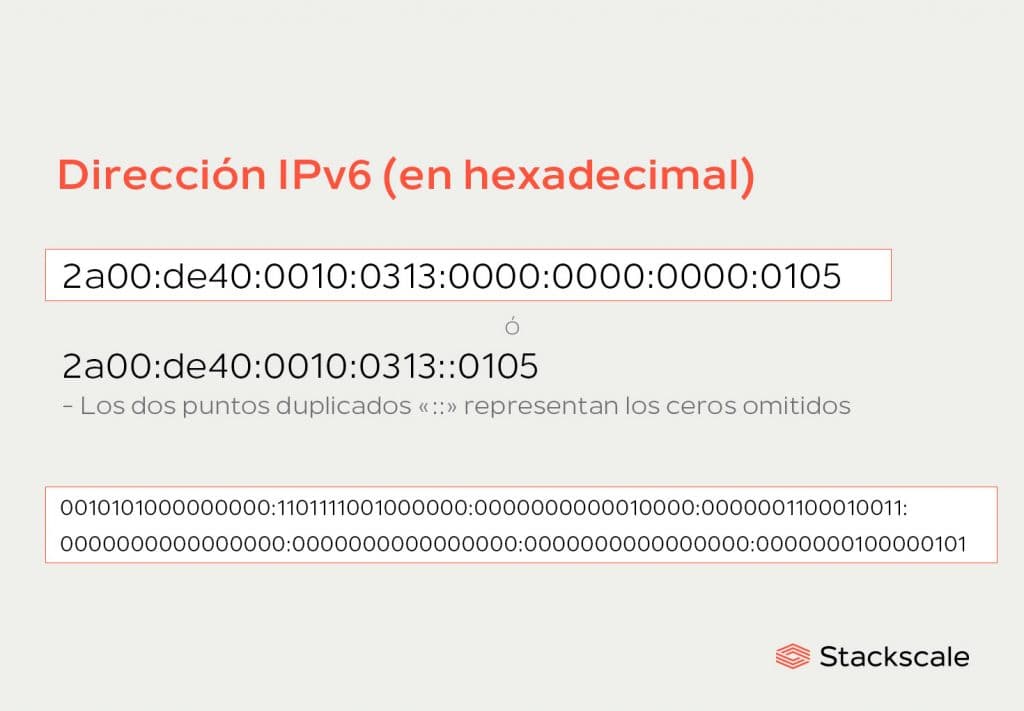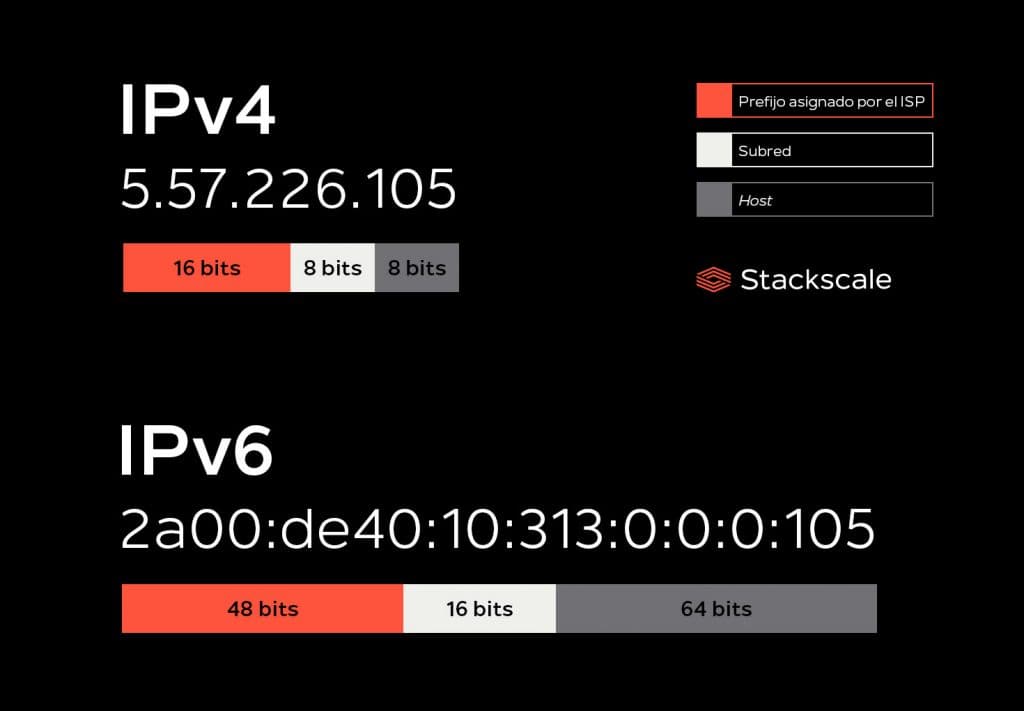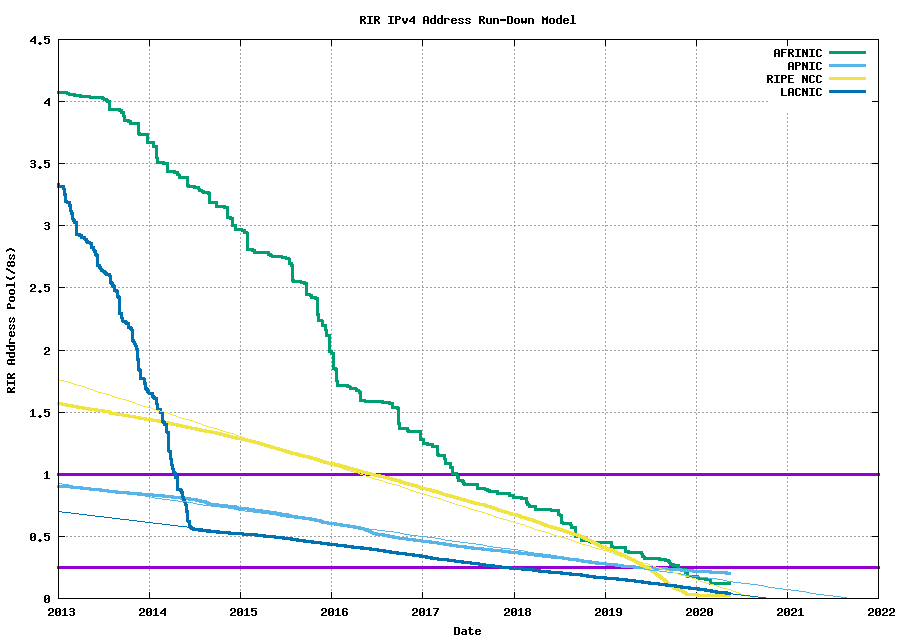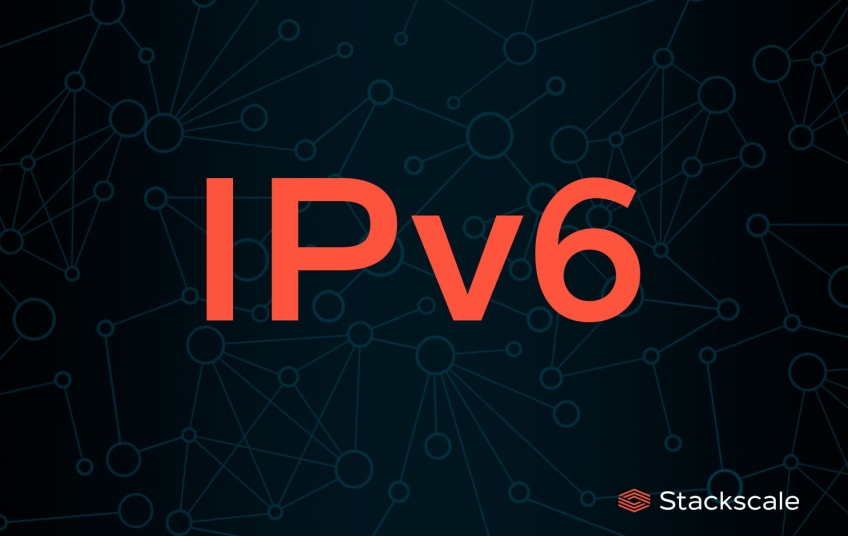Internet Protocol version 6 or IPv6 (Internet Protocol version 6) is a version of the Internet Protocol (IP). The Internet Protocol allows data to be transmitted through a network to IP addresses (IPv4 or IPv6), which are the ones that identify the different devices connected to the Internet and allow communication between them.
IPv6 should eventually replace IPv4. The transition to IPv6 is necessary for technological progress, especially given the exponential growth of connected devices that the development of the Internet of Things (IoT) implies. In addition, the IPv6 protocol presents significant improvements in terms of efficiency, performance and security. Stackscale, since its inception, has been a leader in the implementation of IPv6 in its network and offers the possibility of deploying services to all its clients on this new protocol.
What does an IPv6 address look like?
One of the biggest changes from IPv4 to IPv6 is the length of network addresses. IPv6 addresses are 128 bits, which corresponds to 32 hexadecimal digits. This is a significant improvement over 32-bit IPv4 addresses. Also, IPv6 addresses can be made up of two logical parts: a 64-bit prefix and a 64-bit interface identifier.

The interface identifier is almost always automatically generated from the MAC address of the interface to which the address is assigned. This is one of the advantages of implementing it in the IoT because it allows each connected device to have its own IP address.
Advantages of the IPv6 protocol
These are some of the advantages of this new IP address protocol, IPv6.
Almost unlimited number of unique IP addresses
This new protocol allows each device connected to the Internet to have its own IP address. An advantage that little by little is becoming a requirement with the continuous advance of the Internet of things. So Network Address Translation or NAT (short for Network Address Translation) is no longer necessary.
Native support for mobile devices
IPv6 supports the mobile IPv6 protocol, MIPv6. This protocol allows mobile devices to switch from one network to another and receive roaming notifications regardless of their physical location.
Auto configuration
The new protocol has better methods for performing automatic configuration, which is a significant improvement over the classic DHCP used in IPv4.
Security
The IPv6 protocol can be enhanced with IPsec (Internet Protocol Security) to manage encryption and authentication between hosts . This new protocol provides a robust end-to-end security framework for data transfer. However, since RFC 6434, support for IPsec is only recommended, rather than required, as specified in RFC 4292. To benefit from the authentication and encryption features of IPsec, IPsec must be actively applied.
Efficiency
Packet management is much more efficient because it simplifies the packet header. IPv6 also makes routing more hierarchical and efficient by reducing the size of routing tables.
IPv4 vs. IPv6
Internet Protocol version 4 or IPv4 is the first version of the Internet Protocol , deployed for production on the ARPANET in 1983, and currently the most widely used IP version globally. However, since 010 there has been talk of the end of IPv4 addresses. That is why IPv6 was defined in RFC 2460 with the idea that it would replace the "saturated" IPv4, RFC 791.

IPv6 was designed by Steve Deering of Xerox PARC and Craig Mudge. The goal was to expand the number of IP addresses available on the Internet. Since 2016, IPv6 is being implemented in the vast majority of devices that access the Internet.
What is the problem with the IPv4 protocol?
The problem with the current protocol, IPv4, is the limit of IP addresses it allows—a maximum of about 4.3 billion unique IP addresses.
-
The IANA global pool of available IPv4 addresses was depleted in 2011.
-
RIPE ran out of IPv4 addresses in November 2019.
The new IPv6 standard was born not only to be able to provide a unique IP address to each device in the world with an Internet connection, but also to improve Internet service globally.
IPv4 allows 4,294,967,296 different host addresses. This number is totally insufficient to be able to assign an address to each person on the planet, much less to do so to each device connected to the Internet now and in the future. In contrast, IPv6 supports 340,282,366,920,938,463,463,374,607,431,768,211,456 (2128 or 340 sextillion addresses) addresses for every square millimeter of the Earth's surface. This figure is equivalent to about 6.7 × 1017 (670 quadrillion). This is, without a doubt, one of the keys that will force the real and massive adoption of the IPv6 protoco.
Differences between IPv4 and IPv6
Although both IPv4 and IPv6 are used to identify machines connected to a network, there are many differences between the two protocols. These are some of them:
-
IP address size
-
IPv4: 32 bits
-
IPv6: 128 bits
-
-
Addressing method
-
IPv4: numeric and binary bits separated by a period (.).
-
IPv6: Alphanumeric and binary bits separated by a colon (:).
-
-
IP address classes
-
IPv4: Five different IP address classes.
-
IPv6: almost unlimited number of IP addresses. In addition, it includes support for ranges that are considered "private".
-
-
Setting
-
IPv4: each system must be configured in order to communicate with others. The network is also configured manually or with DHCP.
-
IPv6: Optional configuration according to the functions that are needed and supports auto-configuration between IPv6 devices.
-
-
Interoperability
-
IPv4: Relatively restricted network topologies, with limited interoperability and mobility capabilities.
-
IPv6: interoperability and mobility capacity included in network devices.
-
How many IP addresses are there in an IPv4 /24 and in an IPv6 /64?
The number after the forward slash (/) is the block size assigned to an IP address. This indicates the number of IP addresses within the block. The higher the number after the forward slash, the lower the number of IP addresses within the block, and vice versa.
IP addresses in an IPv4 /24
In an IPv4 /24 there are 256 IPv4 addresses. /24 means that the first 24 bits of the 32 bits of IPv4 are defined by the network. The remaining 8 bits are defined by the host.
The largest block that can be allocated to an IPv4 is /8; these are the blocks assigned to regional registries such as ARIN or LACNIC. For example, in an IPv4 /8 there are 16,777,216 IP addresses. The smallest block that can be assigned to an IPv4 is /32 and it corresponds to a single IP address.
Examples of assignments in IPv4
| Prefix | IPv4 addresses | Mask |
| /32 | 1(20) | 255.255.255.255 |
| /24 | 256(28) | 255.255.255.0 |
| /16 | 65536(216) | 255.255.0.0 |
| /8 | 16777216(224) | 255.0.0.0 |
IP addresses in an IPv6 /64
In an IPv6 /64 there are 18,446,744,073,709,551,616 IPv6 addresses. /64 means that the first /64 bits of the 128 bits of IPv6 are defined by the network. The remaining 64 bits are defined by the host . In IPv6, the minimum block assigned to ISPs by regional and national registries is /32.
CIDR: Classless Inter-Domain Routing
This new method of assigning IP addresses is known as "CIDR" ("Classless Inter-Domain Routing "). CIDR is a network standard for assigning IP addresses and IP routing. It was introduced by the Internet Engineering Task Force (IETF) in 1993. The CIDR allocation method helped slow the rapid depletion of IPv4 addresses.
Status of IPv4 pools by zones

The graph above shows how IPv4 ranges have been rapidly depleted in all regions. Still, the popularization of the IPv6 protocol is proceeding too slowly. One of the reasons is the slow adoption of IPv6 by ADSL and fiber optic providers, who should be the main responsible for its adoption so that all users start browsing natively with the new protocol.
In Spain, we hope that we will not have to wait long for the dominant operators such as Telefónica Movistar, Vodafone, ONO, Jazztel or MásMóvil, among others, to start offering routers with IPv6 by default.
Transition from IPv4 to IPv6 in Europe and Spain
The rate of adoption varies considerably within Europe. While some countries have adoption rates of around 50% or even higher—Belgium (61.95%), Germany (52.02%) and Greece (51.16%)—other countries are still well below the 10% —Spain (2.85%), Italy (4.72%) and Croatia (5.91%), among others—. Check the IPv6 adoption map in the world to know more.
Regarding Spain in particular, all the data that we consulted in different sources indicate that it is a little behind in the implementation of IPv6 for the end user; although it is true that many web pages already support IPv6. But the unfinished business is public bodies such as the Treasury, whose main web page still does not respond to IPv6. The IPv6.es website talks about the different options for the transition from IPv4 to IPv6 by users, companies, public bodies and ISPs.
What happened to IPv5?
IPv5 was defined in 1979, but it was only experimental. That version of the Internet protocol could not replace IPv4 because the number 5 was already assigned. IPv5 was also known as the «Internet Stream Protocol».
IPv6 Protocol on Stackscale
Stackscale has supported IPv6 since its foundation. All our clients can have an IPv6 address totally free. A few million exclusive use IPs; specifically a /64 range that is 2 to the power of 64, which represents 18,446,744,073,709,551,616 of IPv6.





